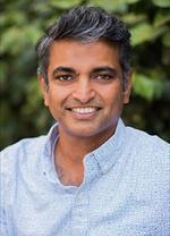UCSF Imaging Lab Lends its Expertise to Hit Television Show
When the Discovery Channel show “MythBusters” needed an expert to help them test the myth that humans use only 10 percent of their brain, they turned to UCSF Department of Radiology and Biomedical Imaging's Dr. Srikantan Nagarajan and the UCSF Biomagnetic Imaging Laboratory. Using a magnetoencephalogram (MEG) study, an individual was given four tests targeting memory, calculation ability, decisions making and visual information processing, followed by another test involving a functional MRI scan. What were the results and what did it take to do the tests? Dr. Srikantan Nagarajan takes us behind the scenes to show us how MythBusters tackled the question.
I got a call from someone who said, "Hi, I am the associate producer of a TV show called ‘MythBusters’..." and I had a long pause because I thought that this was like a spam call of sorts. Then I said, "Sorry, I don't watch TV. How can I help you?" He said, "We are a popular show on Discovery channel, and we bust myths. We are calling to ask you about the myth that you only use 10 percent of your brain. We did some Google search and came across your name as someone who heads a lab that does brain imaging. We were wondering if you could either prove or disprove the myth, and if you can help us with the show?" I said, "It is a very interesting myth that may actually be true if you think a bit deeply about it, that at any point in time you may only be using a tenth of your brain, and that I think that we can do experiments to test the myth." A series of e-mail exchanges and phone calls later, we had designed a script for the segment of the show that would cover our lab. We designed a series of MEG and fMRI exams to activate different parts of the brain – visual tasks to activate occipital lobes, auditory/listening tasks to activate temporal lobe, spatial attention tasks to activate parietal lobes, and executive function tasks to activate frontal lobes.
The shoot occurred over three days – one for MEG data acquisition, one for fMRI acquisition, and the third day for discussion of the results. They were very long days. Their crew works late hours, so we started early afternoon around 1 p.m. The MEG shoot went on until 10 p.m. that night. They took a lot of shots of everyone in the lab and while we collected data on one of the show hosts. All of the people in the lab who don't normally show up just hung out near cameras, and it was quite chaotic. They shot several monologues of me which ended up being cut in the final show.
The second day was the fMRI shoot at the MRSC scanner. They were weird about not showing any brand logos, so you could never tell what sort of scanner was being used in the show. They made us cover up all visible logos with tape. They were so awed by the images from the MR scanner and we were able to show them some real-time fMRI capabilities that they lapped up in the shooting.
The final day was the discussion of results shoot. Again they shot for several hours and recorded many dialogues, which all ended up being edited for something like 45 seconds of, "Here are the results, and you use XXX percent of the brain." I don't want to say if the myth was busted or not, because that would be a spoiler alert about the show.
Overall, the crew was very nice, and the TV stars were so funny and affable, and easy to get along. They are also really, really smart people who work pretty hard for the show. It was weird and a bit contrived to redo the same dialogue three times for different camera angles and you lose the spontaneity of the conversation, it is a bit like déjà vu on a moment by moment basis. But the final edit seemed to be okay.
I was delighted that many of the others in the lab got good face time on TV. In fact, Leighton Hinkley, my postdoc, I think got more screen time that me on the show! So, he is the real star of the show! I was thrilled that they put my name on the credits for helping with the show design.
Tune in this Sunday, December 5, at 9 p.m. E/P to see Dr. Srikantan Nagarajan and the Biomagnetic Imaging Laboratory on The Discovery Channel’s ‘MythBusters’!

